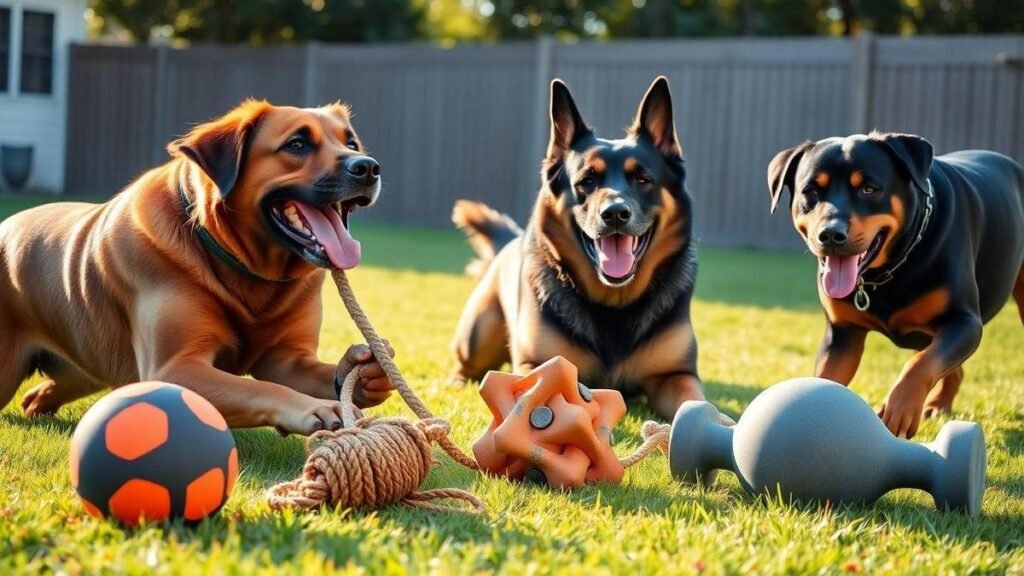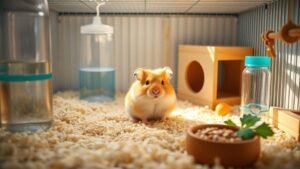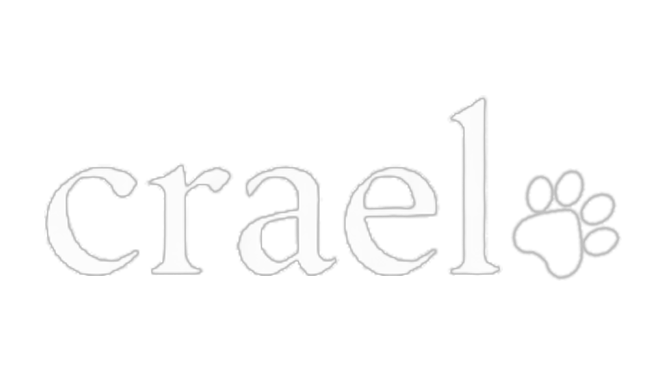Melhores brinquedos interativos para cães grandes em casa
I know the struggle with big dogs. I want durable toys with strong material, tight stitching, and the right size for my dog’s bite force. I choose puzzle toys to build smarts, step up the challenge slowly, and use interactive feeders to slow meals and calm digestion. For outside fun I test launchers for power and ball size. I hunt indestructible chew toys, teach hide-and-seek, pick safe treat-dispensing options, and always balance play with rest so my dog stays happy and safe. When I search, I look specifically for “Melhores brinquedos interativos para cães grandes em casa” to find products made for large breeds.
Key takeaway
- Pick extra-tough toys that resist big bites.
- Use toys that make your dog think and stay busy.
- Match size so play is safe.
- Inspect toys often and retire broken ones.
- Rotate toys to keep interest high — see tips on introducing and rotating new enrichment.
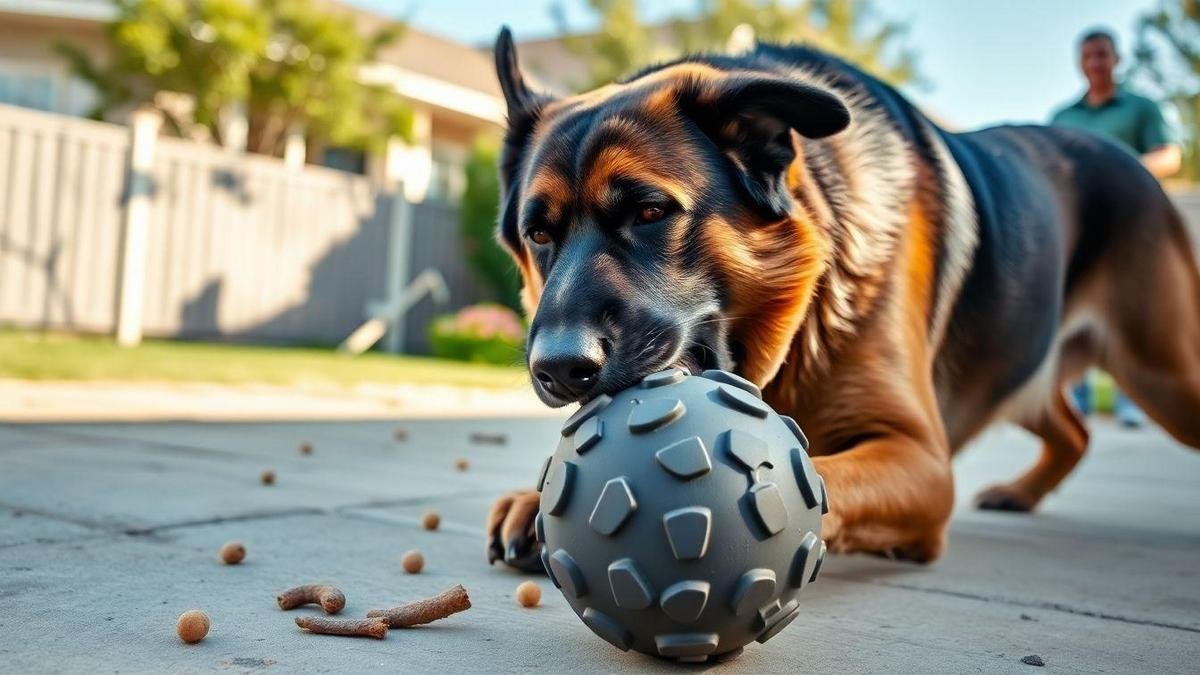
How I choose durable interactive dog toys for big breeds (best interactive toys for large dogs)
I test toys with my big dog and look for Melhores brinquedos interativos para cães grandes em casa that last. I want toys that hold up to hard play and keep him happy. I pick by checking three key areas: material, stitching, and size.
What makes a toy durable: material, stitching, and size
I focus on three signals that tell me if a toy will last.
- Material: heavy-duty rubber, thick nylon, or high-denier fabric — these wear slower than thin plush.
- Stitching: double-stitched seams and bar tacks at stress points. Single stitching pulls apart fast.
- Size: the toy should be bigger than the dog’s mouth so it can’t be swallowed; bigger toys spread chew force across more surface.
| Feature | What I look for | Why it matters |
|---|---|---|
| Material | Heavy-duty rubber, ballistic nylon, thick rope | Resists tearing and punctures |
| Stitching | Double-stitched, reinforced seams | Prevents seam failure under tug |
| Size | Larger than muzzle, no loose parts | Reduces choking and swallowing risk |
I treat a toy like clothing: fabric and seams tell the truth. Avoid toys that feel thin or have squeakers near the surface.
Matching toy strength to your dog’s bite force
Match the toy to how hard your dog bites and plays.
- Light chewers: softer rubber or reinforced plush.
- Moderate chewers: thick rope or nylon.
- Aggressive chewers: solid rubber or braided materials designed for heavy use.
| Bite style | Toy types I choose |
|---|---|
| Light | Soft rubber, reinforced plush |
| Moderate | Braided rope, tough nylon |
| Heavy | Solid rubber, commercial-grade chew rings |
Watch play closely at first. If a toy rips quickly, move up a strength level. Rotate toys so none wear out too fast.
Inspecting labels and safety claims before I buy
Read labels like a contract. Check for:
- Non-toxic materials and clear ingredient lists.
- Size or breed recommendations.
- Certification or third-party testing claims.
- Warranty, replacement policy, or satisfaction guarantee.
- No small parts or loose pieces that break off.
Real photos in reviews tell me more than marketing words. If a maker offers a clear return or replacement policy, I trust the product more.
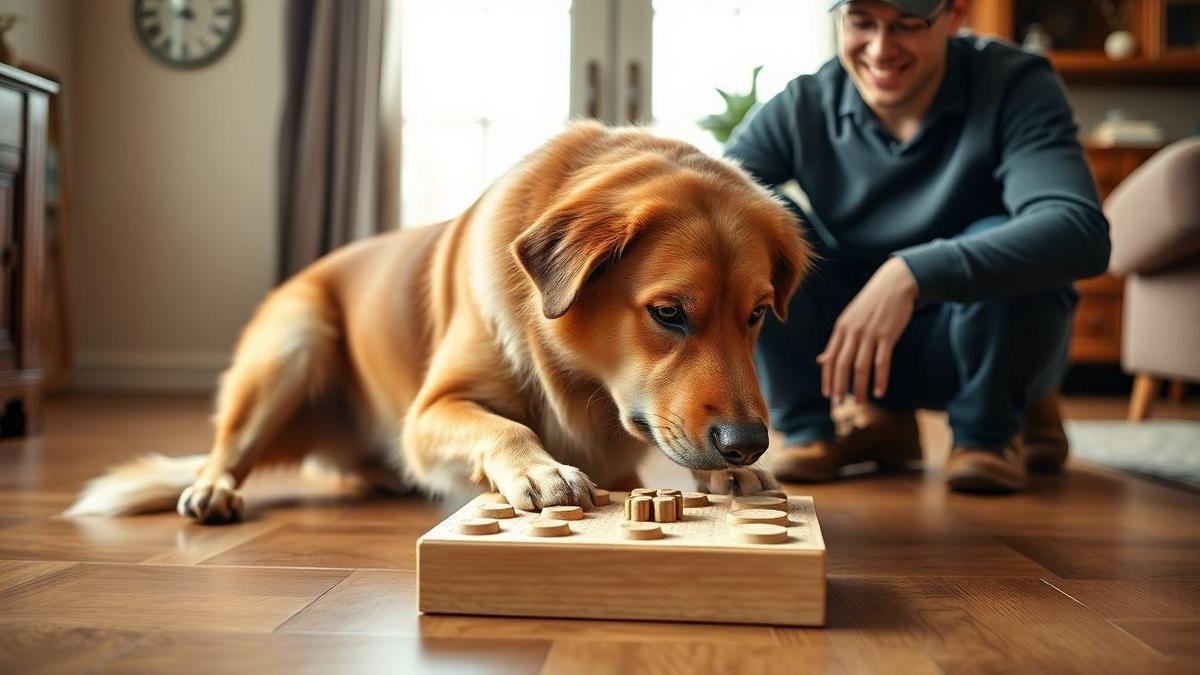
Why I pick puzzle toys for big dogs to boost their mind
Big dogs need mental exercise as much as walks. I look for Melhores brinquedos interativos para cães grandes em casa when I shop — puzzles keep them busy, calm, and happy. For recognizing when a dog needs more work, I follow a few mental stimulation strategies to decide which puzzles to try first.
A good puzzle should be durable, safe, and fun.
Simple to hard puzzles: how I raise the challenge
Start easy, then add difficulty. Too hard = quits. Too easy = boredom.
| Level | Example toy | What I want | Play length |
|---|---|---|---|
| Simple | Treat-dispensing ball | Quick success, builds confidence | 5–10 min |
| Medium | Sliding compartments | Uses nose and paws | 10–20 min |
| Hard | Multi-step puzzles | Problem solving and patience | 20–40 min |
I often build low-cost challenge toys at home; for inspiration I use DIY puzzle feeder ideas to scale difficulty without buying dozens of gadgets. If my dog finishes a simple toy in two minutes, I move up. I scatter treats outside and use harder puzzles inside to mix things up.
How puzzle play helps stop boredom and chewing
Puzzles give dogs a job. A busy brain = a calm body. Over weeks, chewing on shoes dropped and naps grew longer.
Use puzzles at times your dog gets restless:
- Before leaving the house: a treat toy keeps him calm.
- After a walk: a harder puzzle burns extra energy.
Also pair puzzles with scent work and quiet routines to enhance calm — see methods for scent enrichment for indoor dogs.
Choosing puzzle parts that are safe and easy to clean
Pick puzzles with few detachable parts and easy cleaning.
- Dishwasher-safe or rinseable.
- Made of non-toxic materials.
- Free of small parts that can break.
Quick checklist before buying:
- Piece size fits the dog’s mouth.
- No sharp edges.
- Smooth seams that don’t trap food.
- Replacement parts available.
Clean puzzles after heavy use to remove residues and odors.
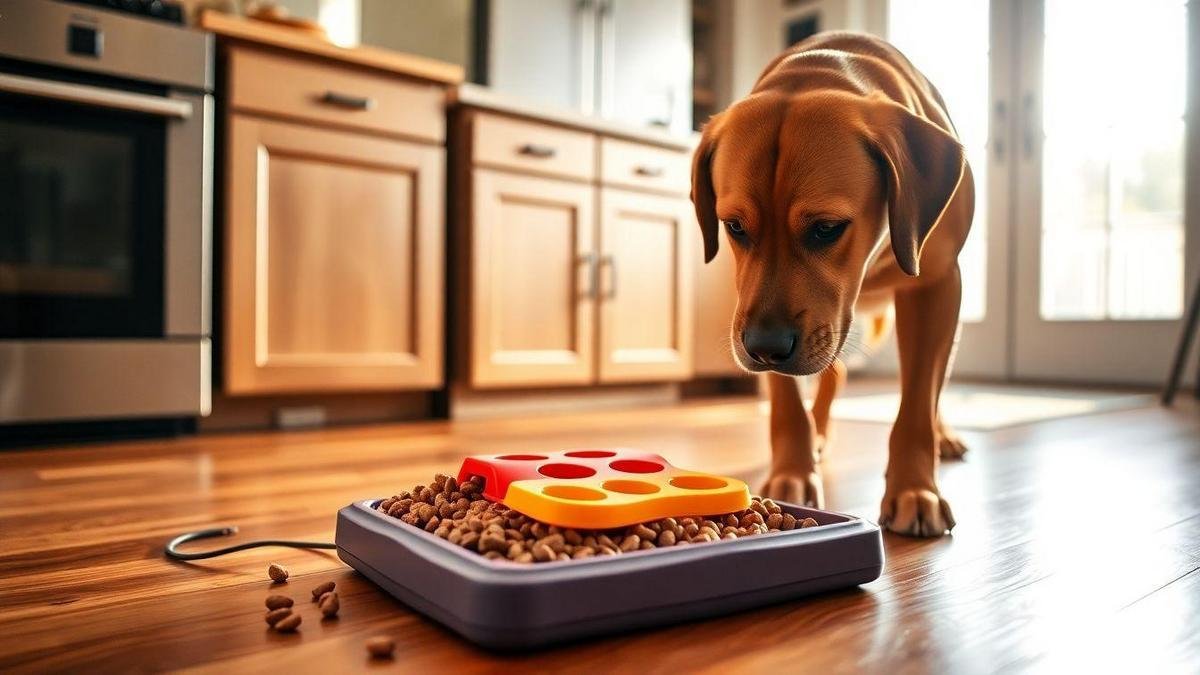
How I use interactive feeder toys for big dogs to slow eating
Types I trust: slow-feed bowls, snuffle mats, and treat puzzles
I use three main tools to slow my big dog down: slow-feed bowls, snuffle mats, and treat puzzles. Each targets a different instinct and lengthens mealtime.
| Type | Best for | How I use it | What I like |
|---|---|---|---|
| Slow-feed bowl | Fast eaters | Fill with kibble or mix wet dry | Slows gulping, simple to clean |
| Snuffle mat | Nose work fans | Hide kibble in fabric folds | Mentally tiring and calming |
| Treat puzzle | Problem solvers | Use for kibble or high-value treats | Builds patience and focus |
When you want to make your own, a quick DIY snuffle mat can be a durable, washable option for large breeds. Introduce new feeders while sitting with your dog for the first few minutes and praise progress.
Health gains I see: better digestion and calmer meals
After switching to feeder toys:
- Less gulping: food mixes with saliva and digests better.
- Calmer mealtime: reduced anxiety and less mess.
- Mental stimulation: tiring the brain helps them sleep better.
My Lab used to finish dinner in under two minutes; with a snuffle mat the same meal takes 8–10 minutes.
Filling and washing tips to keep feeders safe
Treat feeders like plates and toys: clean often and inspect for wear.
| Task | My routine | Why it matters |
|---|---|---|
| Filling | Use measured portions; hide kibble in folds | Keeps portions steady, food lasts |
| Daily wash | Warm water mild dish soap after use | Removes oils and residue |
| Deep clean | Vinegar rinse weekly for mats; dishwasher if labeled | Kills lingering bacteria |
| Inspect | Look for cracks or loose pieces weekly | Prevents choking hazards |
Steps I follow: measure food, put food in the toy not on the floor, wash after use, replace damaged feeders. Let mats dry fully in the sun and keep multiple feeders in rotation. For daily routine help, pair feeder sessions with a consistent schedule — see ideas for building a daily routine for indoor pets.
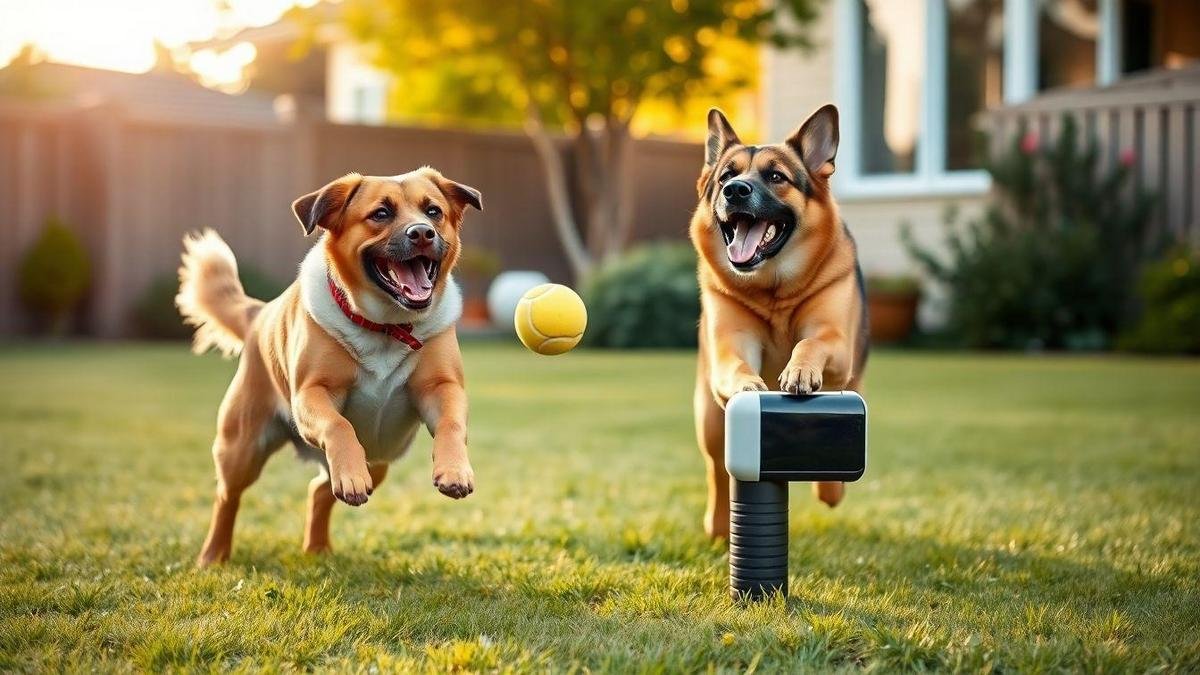
My guide to automatic ball launchers and outdoor play for big dogs
Power, range, and ball size I check before buying
Start with power and adjustable settings. Typical range is 10–40 ft. For ball size I prefer 3″ balls for big jaws and soft rubber to protect teeth.
| Feature | What I look for | Note |
|---|---|---|
| Power | Low / Medium / High (adjustable) | High for strong retrievers |
| Range | 10–40 ft | Match to yard or park |
| Ball size | 2.5″ standard vs 3″ large | I prefer 3″ for big jaws |
| Ball material | Soft rubber, durable | Avoid hard balls that hurt teeth |
I also check ball weight—heavier balls fly straighter in wind but must suit jaw strength.
Safe play rules I use in the yard or park
Safety is the priority:
- Supervise: never leave the launcher active with the dog unsupervised.
- Warm-up: short throws for 5 minutes before intense play.
- Breaks: water and rest every 10–15 minutes.
- Surface check: avoid slippery or rocky areas; soft grass is best.
- Place launcher on stable ground and away from edges.
- Inspect balls for splits or chunks before each session.
- Use a leash in public until reliable recall is established.
I learned this after my dog slipped on wet grass and tweaked a shoulder—now we warm up and choose dry turf. For managing bursts of energy indoors or changing play when outside isn’t an option, I use strategies from managing zoomies indoors.
Choosing a launcher that matches your dog’s strength and space
Match bite strength, available space, and launcher durability.
| Space | Recommended range | Power level | Ball |
|---|---|---|---|
| Small yard (<25 ft) | 10–20 ft | Low–Medium | 3″ soft rubber |
| Medium yard (25–50 ft) | 20–35 ft | Medium | 3″ durable rubber |
| Large open space (>50 ft) | 30–40 ft | High | 3″ heavy ball |
Test new launchers gently and watch how your dog catches and carries the ball. If the launcher tosses too hard, lower it or stop. For keeping dogs active overall and helping with weight control, combine launchers with other enriching toys recommended in active-toy strategies that fight obesity.
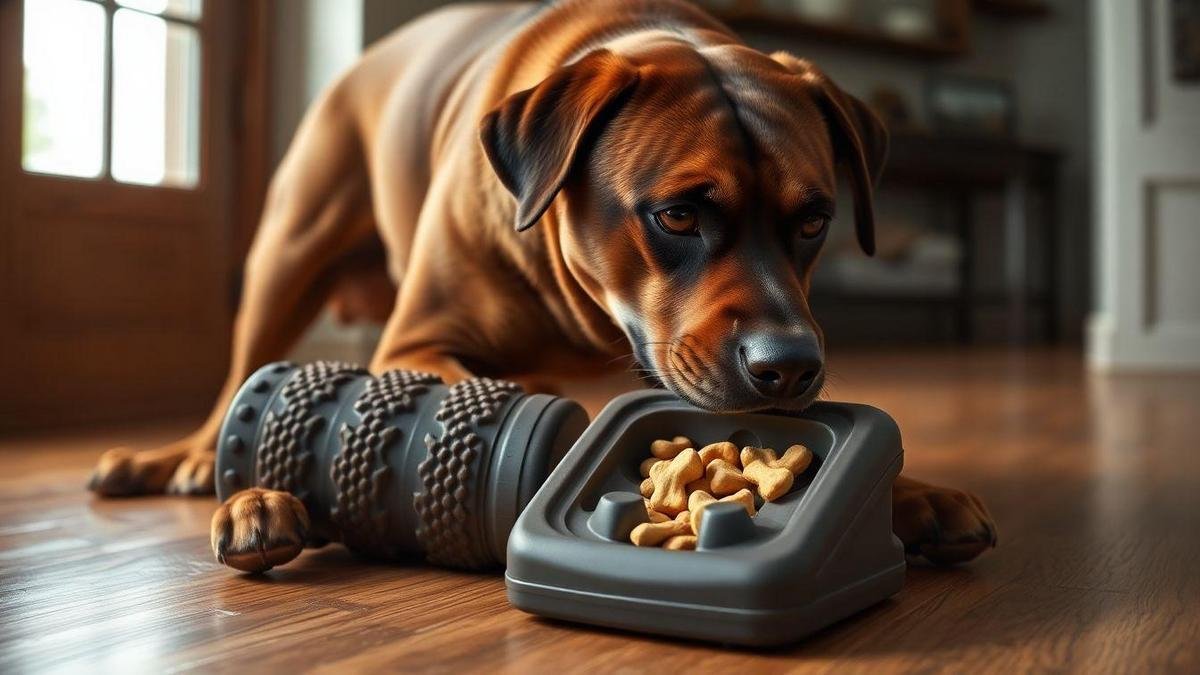
How I find indestructible interactive toys for large breeds and tough chewers
I look for toys that stand up to big jaws and rough play. I keep “Melhores brinquedos interativos para cães grandes em casa” in mind so I find options made for hard use.
Strong materials and trusted brands I recommend
Materials indicate longevity. Compare materials and brands.
| Material | Why I like it | Example brands | Best for |
|---|---|---|---|
| Natural rubber (firm) | Tough with some give | KONG (Extreme) | Chewers who carry and fetch |
| Hard nylon | Very wear-resistant | Nylabone, Benebone | Power chewers who gnaw |
| Reinforced rubber/TPE | Flexible, resists punctures | West Paw (Zogoflex) | Interactive puzzles and fetch |
| Engineered chew rings | Built with safety stops to avoid swallowing | Goughnuts | Serious chewers |
| Ballistic rope / braided fibers | Holds up to tug, cleans teeth | Certain rope lines | Tug and teeth-cleaning play |
My Lab shredded a soft squeaker once. Switching to a KONG Extreme filled with treats made playtime last much longer. Material matters more than a cute shape.
When I retire a toy: wear signs to watch for
I retire toys fast when they show damage. Safety first.
| Wear sign | What I do |
|---|---|
| Deep cracks or missing chunks | Remove and discard immediately |
| Thin spots or frayed fibers | Stop use; replace with tougher model |
| Exposed stuffing or hard core | Replace to avoid choking |
| Loose or missing parts | Toss — never glue or stitch for play |
| Sharp edges or rough bits | Replace; can cut gums |
Check toys weekly during play. Store older worn toys out of reach and only use them under supervision until you toss them.
Pairing indestructible chew toys with supervised play
Even the toughest toys deserve supervision:
- Keep play sessions short and focused; watch for tired or over-excited signs.
- Rotate toys so one item doesn’t wear down fast.
- Use the toughest toys for supervised chew time, softer toys for calm indoor play.
- If your dog breaks pieces off, swap the toy immediately.
Test a new toy for a few minutes. If it shows fast wear, remove it. Supervision is a small effort with a big safety payoff. For tips on introducing and managing new enrichment items, consult best practices for new toys and enrichment.
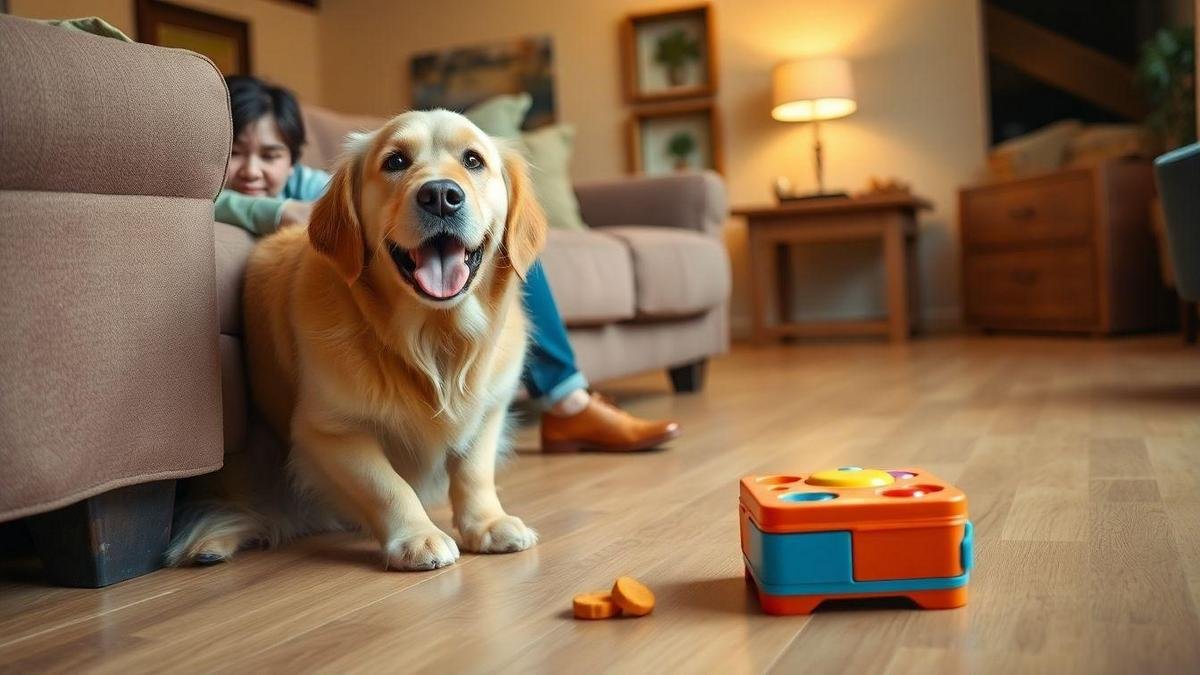
How I teach hide-and-seek and use treat-dispensing toys indoors
Teaching indoor games and using treat-dispensing toys is part of finding great Melhores brinquedos interativos para cães grandes em casa.
Steps I follow for hide-and-seek with large dogs
Start simple: show the toy and treat, use a calm voice, then hide it in easy spots. Praise every find and make hides gradually harder. Hide-and-seek is one of the most effective indoor bonding games I use to build engagement and recall.
Steps:
- Show the toy and treat; give a small reward.
- Hide the toy partially so he can sniff it out.
- Move to fully hidden spots after two successes.
- Add a cue like find it before hiding.
- If stuck, make it easier, then try again.
Always supervise and pick toys labeled strong and suited to large breeds.
Picking treat-dispensing toys for big dogs: size and treats
Size matters first. Big dogs need larger openings and firm materials. Test a toy by squeezing it — if it feels flimsy, skip it. Consider treats: soft treats can clog some devices; hard or chunked treats work better in larger dispensers.
| Toy type | Best for | Treat examples | Tip |
|---|---|---|---|
| Large rubber ball | Heavy chewers | Dry kibble, large biscuits | Pick thick rubber |
| Puzzle box | Smart dogs | Chunky treats, freeze-dried | Start on easy level |
| Slow-feeder ball | Active chewers | Small to medium kibble | Adjust hole size if possible |
| Durable rope w/ pocket | Tug find play | Wrapped treats, soft bits | Supervise for frayed rope |
Avoid toys with tiny parts. Treat-dispensing toys add calories, so cut a few kibble pieces from meals. First time with a treat toy, sit with your dog—most catch on within a few tries.
Balancing play sessions with rest
Match session length to age and energy. High-energy big dogs: 15–20 minutes of intense play; older dogs: 5–10 minutes gentler. After play give 20–30 minutes quiet time to aid digestion and prevent overstimulation. For teaching calm behavior after play, I use methods from settle-on-command training.
Signs a break is needed:
- Heavy panting or drooling
- Slower responses
- Loss of focus
- Lying down and not getting up
| Energy level | Play time | Rest time |
|---|---|---|
| High | 15–20 min | 30–60 min |
| Medium | 10–15 min | 30 min |
| Low / Senior | 5–10 min | 45–60 min |
End sessions on a win — quick success leaves your dog eager for the next round.
Top recommended features for Melhores brinquedos interativos para cães grandes em casa
When searching for “Melhores brinquedos interativos para cães grandes em casa”, prioritize these features:
- Size appropriate for large muzzles and strong jaws.
- Heavy-duty materials: firm natural rubber, hard nylon, reinforced TPE.
- Easy cleaning: dishwasher-safe or rinseable parts.
- Replaceable parts or warranties for long-term use.
- Adjustable difficulty for puzzles and launchers.
- Non-toxic and certified materials when possible.
These features help you choose items that last and keep your dog safe and stimulated. Pair toy selection with a consistent daily plan — see how to build a daily routine for indoor pets that supports enrichment and rest.
Conclusion
Finding toys that hold up for a big dog takes testing and attention. I stick to three rules: pick durable materials, match size to your dog’s mouth, and supervise new play. Start easy with puzzles and raise the challenge slowly. Inspect toys weekly, retire anything with cracks or frays, and treat feeders like plates—clean, rotate, and measure portions. For fetch, balance power and range, and warm up before full-speed play. For chewers, favor solid rubber, nylon, or engineered chew rings.
Mental work matters as much as exercise. Use puzzle toys and snuffle mats to curb boredom chewing and barking, and follow scent and enrichment options for calmer indoor time described in scent enrichment guides. Balance play with rest—short, focused sessions followed by quiet time help digestion and keep your dog calm.
In short: choose tough, safe toys; match strength to bite force; rotate and clean; supervise; and pace play with rest. These habits keep large dogs happier, healthier, and more engaged. For more picks and tips, see https://blogcraelo.com.
Frequently asked questions
- What are the best tough toys for big chewers?
I pick heavy-duty rubber and thick rope toys. Avoid small parts and soft foam that shred quickly.
- Can puzzle toys work for large dogs at home?
Yes. I use puzzle feeders daily. They provide mental work as much as physical play. Searching “Melhores brinquedos interativos para cães grandes em casa” helps me find sturdy puzzles and you can also try DIY puzzle feeder options to start.
- How do I choose a safe interactive toy for my big dog?
Check size, material, and chew rating. Replace toys if they crack or fray and supervise new toys.
- Are automatic ball launchers good for big dogs?
They can be excellent for extra exercise. Start slow, supervise, and choose units made for large breeds. Combine launchers with other active toys to support healthy weight.
- How often should I rotate toys to keep my big dog interested?
Swap toys every few days. Hide some and bring them back later — rotation increases focus and reduces boredom.
- Where can I find Melhores brinquedos interativos para cães grandes em casa?
Look for product pages and reviews that specify large-breed sizes and heavy-duty materials; use the keyword “Melhores brinquedos interativos para cães grandes em casa” when searching to filter for durable options, and follow guides on introducing new enrichment safely.

